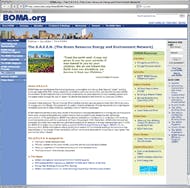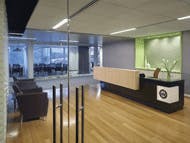Newsworthy
Marriott Initiatives Reduce Greenhouse Gases
Washington, D.C.-based Marriott Intl. Inc. is set to reduce its greenhouse-gas emissions by nearly onefifth over a 10-year period from 2000 to 2010. The effort is part of a comprehensive, global campaign to reduce Marriott's environmental footprint and save energy costs. Designating April as Environmental Awareness Month, Marriott invited its 2,800 hotels - along with its associates, owners, and guests - to engage in initiatives to preserve natural surroundings and reduce resource consumption. The hospitality company launched a pilot recycling program at 30 hotels to measure, standardize, and expand recycling companywide. Programs already making a difference in clude:
- The "Re-Lamp" campaign, which replaced 450,000 light bulbs with fluorescent lighting in 2006 and saved 65 percent on overall lighting costs and energy usage in guestrooms.
- The Linen Reuse Program, which encourages guests to reuse linens and towels during their stay, saved an aver- age of 11 to 17 percent on hot water and sewer costs involved in laundering operations.
- The replacement of 4,500 outdoor signs with LED and fiber-optic technology, yielding a 40-percent reduction in outdoor advertising energy use in its first year.
- The installation of 400,000 new showerheads, reducing hot-water usage by 10 percent each year.
- The procurement of ENERGY STAR®-compliant technology, including desktops, laptops, printers, and scanners. Marriott's Technology Asset Disposal Program has also collected thousands of old computers and cell phones for reuse or safe disposal.
- The designation of an Energy and Environmental Ambassador at each hotel to help maintain standards and find new ways to improve the environment.
MIT Develops Antimicrobial Coating
What if paint could help stop the spread of germs and disease? This possibility may be closer to reality with a new "antimicrobial paint" recently developed by professors and researchers at the Cambridge, MA-based Massachusetts Institute of Technology (MIT). The coating can be sprayed or brushed onto doorknobs and surfaces to fight the spread of influenza. Certain types of bacteria, including E. coli and S. aureus, can also be broken down by the substance and do not appear to become resistant to it. The "paint" consists of spiky polymers that poke holes in the membranes surrounding the virus. According to researchers, the polymer coating should last about as long as a coat of paint. To maintain the coating, washing the surface with soapy water occasionally is required.
Nevada Cancer Facility Embraces Surroundings
On Nov. 6, 2006, the Carson Tahoe Regional Healthcare Foundation officially opened its Carson Tahoe Cancer Center in Carson City, NV, to provide comprehensive cancer-treatment services. Designed by the Sacramento, CA, office of HGA Architects and Engineers, the $12 million, 34,000-square-foot facility is located on 5 acres of the 85-acre Carson Tahoe Medical Campus. The 2-story structure revolves around hospitality and nature. The façade features stonenative to Nevada, the skylights in the waiting areas filter natural light, and large stone fireplaces grace the arrival spaces, promoting the hospitality-like environment.
SMACNA Guide Now Available
The Sheet Metal and Air Conditioning Contractors' National Association (SMACNA), based in Chantilly, VA, has published the newly revised third edition of the "HVAC Duct Systems Inspection Guide." The guide reviews materials and reinforcement of duct systems, as well as assembly and supports of ducts. In addition, it contains guidelines for the inspection of commercial HVAC duct systems for compliance with the SMACNA/ANSI "HVAC Duct Construction Standards, Metal and Flexible," third edition, and "Fibrous Glass Duct Construction Standards," seventh edition. The "Fire, Smoke, & Radiation Damper Installation Guide," fifth edition, also summarizes installation details. Checklists are included for ductwork and fire dampers. To order, visit (www.smacna.org/bookstore).
USGBC Moves into LEED Platinum Headquarters
The Washington, D.C.-based U.S. Green Building Council (USGBC), creator of the LEED Green Building Rating System, is practicing what it preaches. The Service Employees Intl. Union (SEUI) building (which houses the organization's new headquarters) is certified LEED Gold for New Construction, and the USGBC's office suite has earned LEED Platinum certification for Commercial Interiors. Green features include:
- Abundant natural daylight and operable windows (93 percent of the interior has a view of the outdoors).
- Lighting products engineered for high efficiency and low energy use. Individual task lights allow employees to control the amount of light in their work areas.
- Using 40-percent less water with low-flow plumbing fixtures, dual-flush toilets, and waterless urinals.
- Rapidly renewable bamboo, linoleum, and cork flooring installed throughout the space, along with fully recyclable, state-of-the-art carpet tile.
ASHRAE Introduces New Certification
A program to certify healthcare facility design professionals will soon be offered by the Atlanta-based American Society of Heating, Refrigerating and Air-Conditioning Engineers (ASHRAE). The first examination will be held on June 28 in Long Beach, CA, following ASHRAE's Annual Meeting. Subsequent examinations will be Web-based at testing facilities nationwide.
The technical content for the healthcare facility design certification exam was developed in conjunction with the Chicago-based American Society for Healthcare Engineering (ASHE). ASHRAE will work with other industry organizations to develop additional certification programs, including sustainability, commissioning, and building operations and management. For more information, visit (www.ashrae. org/certification).
Lighting Company Offers Tips for Combating Light Pollution
The stars may soon seem even farther away if recent research on light pollution is correct. At the current rate of increasing light pollution, researchers claim that no dark skies will remain in the continental United States by 2025. Many lights installed outside of commercial buildings are too bright and aimed upward or sideways, scattering the light and brightening the night sky. Light pollution can cause adverse health effects, obscure the stars in cities, waste energy, and damage the environment. Coopersburg, PA-based Lutron Electronics Inc. offers these 5 tips to reduce light pollution at your building and contribute to reversing the problem:
- Evaluate lighting plans and redesign some (or all) of the plans, depending on whether existing light is actually needed.
- Utilize light sources of minimum intensity necessary to accomplish the light's purpose, such as using dimmers.
- Turn lights off using a timer or occupancy sensor.
- In the evening, close blinds and shades to prevent indoor light from escaping into the night sky.
- Keep light directed toward the ground or exactly where it is needed. Light fixtures that control light placement and brightness, minimize glare, and save energy are the best kind to use.
IFMA Foundation Prepares FMs for Outbreaks
The Houston-based Intl. Facility Management Association (IFMA) Foundation has released the Pandemic Preparedness Manual to help facility managers plan for, control, and respond to concerns of Avian influenza and pandemic influenza outbreaks. Available on its website (www.ifma foundation.org), the manual recommends steps to take to help control the flu, beginning with training regarding awareness and prevention measures. Organizations are encouraged to make supplies (such as tissues, hand soap, and sanitary wipes) available and to sanitize commonly touched surfaces. In preparation for a possible Avian flu outbreak, the manual also suggests that facility professionals perform preplanning and develop business-continuity plans.



